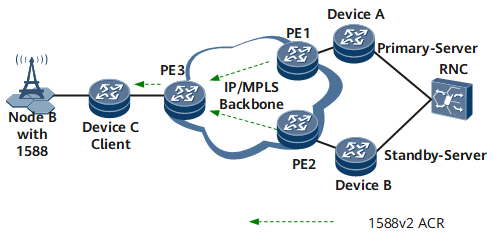Example for Configuring 1588 ACR Clock Synchronization in a Dual-Server Scenario
In a 1588 ACR domain, a client sets up the client/server relationship with two remote clock servers that work in the master/slave mode, and sends a unicast negotiation request to the two clock servers to restore clock information. Once the master clock server becomes faulty, the client sends a request for establishing a connection to the slave clock server.
Networking Requirements
As shown in Figure 1, Device A and Device B function as clock servers that work in the master/slave mode. As a client, Device C first sends a 1588 ACR Layer 3 unicast negotiation request to Device A that functions as the master clock server to obtain clock synchronization information. If the link between DeviceC and DeviceA goes Down, DeviceC sends a Layer 3 unicast negotiation request to DeviceB to ensure that its clock is synchronized with that of the clock server.
Configuration Roadmap
The configuration roadmap is as follows:
Configure DeviceA as server 1.
Configure DeviceB as server 2.
Configure DeviceC as a client.
Adjust Layer 3 unicast negotiation parameters on the client and the servers.
Configure unicast negotiation on servers and the client.
On the client, configure a PTP clock reference source.
Data Preparation
To complete the configuration, you need the following data:
IP addresses of the servers and the IP address of the client
Interval for sending Sync, Delay_Resp and Announce packets on the servers
Procedure
- Configure DeviceA as server 1.
<DeviceA> system-view [~DeviceA] interface loopback 0 [*DeviceA-Loopback0] ip address 1.1.1.1 32 [*DeviceA-Loopback0] commit [~DeviceA-Loopback0] quit [*DeviceA] ptp-adaptive enable [*DeviceA] ptp-adaptive device-type server [*DeviceA] ptp-adaptive local-ip 1.1.1.1 [*DeviceA] commit
- Configure DeviceB as server 2.
<DeviceB> system-view [~DeviceB] interface loopback 0 [*DeviceB-Loopback0] ip address 2.2.2.2 32 [*DeviceB-Loopback0] commit [~DeviceB-Loopback0] quit [*DeviceB] ptp-adaptive enable [*DeviceB] ptp-adaptive device-type server [*DeviceB] ptp-adaptive local-ip 2.2.2.2 [*DeviceB] commit
- Configure DeviceC as a client.
<DeviceC> system-view [~DeviceC] interface loopback 0 [*DeviceC-Loopback0] ip address 3.3.3.3 32 [*DeviceC-Loopback0] commit [~DeviceC-Loopback0] quit [*DeviceC] ptp-adaptive enable [*DeviceC] ptp-adaptive device-type client [*DeviceC] ptp-adaptive local-ip 3.3.3.3 [*DeviceC] ptp-adaptive remote-server1-ip 1.1.1.1 [*DeviceC] ptp-adaptive remote-server2-ip 2.2.2.2 [*DeviceC] commit
- Adjust Layer 3 unicast negotiation parameters on the client and the servers.
# Configure the client.
[*DeviceC] ptp-adaptive request sync-interval 4 [*DeviceC] ptp-adaptive request announce-interval 12 [*DeviceC] ptp-adaptive request delay-resp-interval 6 [*DeviceC] commit
- Configure unicast negotiation on servers and the client.
# Configure server 1.
[*DeviceA] ptp-adaptive acr unicast-negotiate enable [*DeviceA] commit
# Configure server 2.
[*DeviceB] ptp-adaptive acr unicast-negotiate enable [*DeviceA] commit
# Configure the client.
[*DeviceC] ptp-adaptive acr unicast-negotiate enable [*DeviceC] commit
- On the client, configure a PTP clock reference source.
[*DeviceC] clock source ptp synchronization enable [*DeviceC] clock source ptp priority 1 [*DeviceC] clock source ptp ssm prc [*DeviceC] commit
- Verify the configuration.
# Check the 1588 ACR configuration on DeviceC.
<DeviceC> display ptp-adaptive all Device config info ------------------------------------------------------------------------------ Ptp adaptive state :enable Device type :client Sync mode :frequency Current state :slave Packet dscp :56 Domain value :4 Announce interval :11 Announce duration :300s Sync interval :3 Sync duration :300s Delay_resp interval :4 Delay_resp duration:400s Announce receipt timeout:3 One-way or two-way :one-way Local ip :3.3.3.3 Profile :frequency Client board :3 VPN :none BMCA run info ------------------------------------------------------------------------------ Current trace source :server1 Time performance statistics ------------------------------------------------------------------------------ Realtime(T2-T1) :+0s, 23281ns Max(T2-T1) :+0s, 26277ns Min(T2-T1) :+0s, 21853ns Remote server info ------------------------------------------------------------------------------ Ip address Negotiate state SSM Priority PTSF Server1: 1.1.1.1 Nego success PRC 1 normal Server2: 2.2.2.2 Nego success PRC 1 normal
# Check the 1588 ACR configuration on the server. Take the display on DeviceA as an example.
<DeviceA> display ptp-adaptive all Device config info ------------------------------------------------------------------------------ Ptp adaptive state :enable Device type :server Sync mode :frequency Current state :master Packet dscp :56 Domain value :4 Local ip :1.1.1.1 Profile :frequency Server board :3 VPN :none Client info ID Ip Address Clock ID Mode Announce Sync Delay_resp ------------------------------------------------------------------------------ 1 500 3.3.3.3 00259efffed1efcf two-way 1 -3 -3 2 489 4.4.4.4 286ed4fffebcdc76 one-way 1 -3 -3
Configuration Files
Configuration file of DeviceA
# sysname DeviceA # ptp-adaptive enable ptp-adaptive device-type server ptp-adaptive local-ip 1.1.1.1 ptp-adaptive acr unicast-negotiate enable # interface Loopback0 ip address 1.1.1.1 255.255.255.255 # returnConfiguration file of DeviceB
# sysname DeviceB # ptp-adaptive enable ptp-adaptive device-type server ptp-adaptive local-ip 2.2.2.2 ptp-adaptive acr unicast-negotiate enable # interface Loopback0 ip address 2.2.2.2 255.255.255.255 # returnConfiguration file of DeviceC
# sysname DeviceC # ptp-adaptive enable ptp-adaptive device-type client ptp-adaptive local-ip 3.3.3.3 ptp-adaptive remote-server1-ip 1.1.1.1 ptp-adaptive remote-server1-ip 2.2.2.2 ptp-adaptive request sync-interval 4 ptp-adaptive request announce-interval 12 ptp-adaptive request delay-resp-interval 6 ptp-adaptive acr unicast-negotiate enable clock source ptp synchronization enable clock source ptp priority 1 clock source ptp ssm prc # interface Loopback0 ip address 3.3.3.3 255.255.255.255 # return
